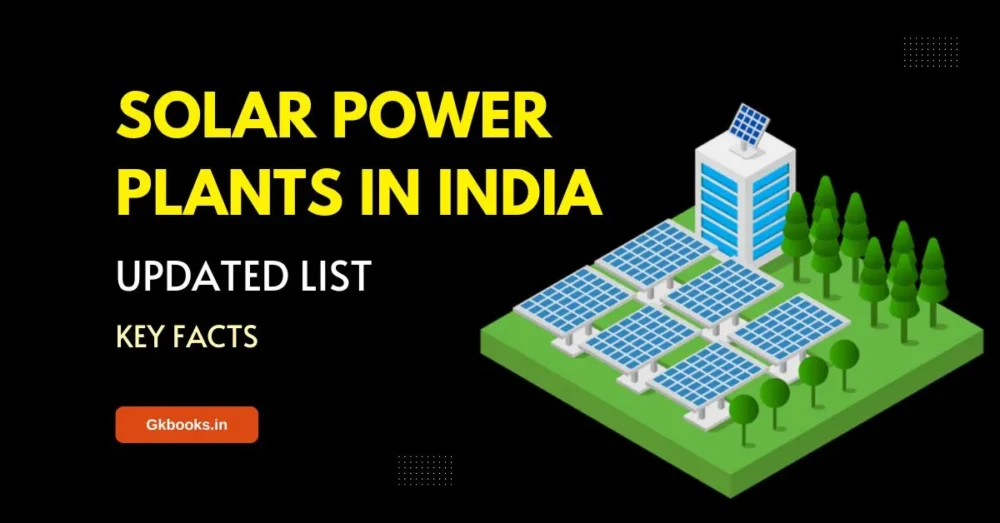Explore all the major facts about NTPC-Ramagundam, India’s largest floating solar power plant. Discover how this innovative project is revolutionizing renewable energy.
India’s Largest Floating Solar Power Plant
India has reached a significant milestone in its renewable energy journey by successfully commissioning its largest floating solar power project.
The Ministry of Power proudly announces the full operationalization of the 100 MW Floating Solar Power Project at NTPC-Ramagundam, marking a remarkable achievement in the country’s green energy initiatives.
✅ Also Read: List of all major solar power plant in India with MAP & Key Notes
Operationalization and Expansion
NTPC, the leading power utility, has declared the commercial operation of the final 20 MW capacity of the Ramagundam Floating Solar PV Project in Telangana, effective July 1, 2022.
With this addition, the total commercial operation of floating solar capacity in the Southern Region has surged to an impressive 217 MW.
Before this achievement, NTPC announced the commencement of commercial operations for a 92 MW floating solar project in Kayamkulam, Kerala, and a 25 MW floating solar project in Simhadri, Andhra Pradesh.
India’s largest floating solar power project commissioned
— PIB India (@PIB_India) July 1, 2022
💠100 MW Floating Solar Power Project fully operationalized at NTPC-Ramagundam
💠Total commercial operation of Floating Solar Capacity in Southern Region rises to 217 MW
Read here: https://t.co/87HEdRT2Up pic.twitter.com/dEbJ4L7h4B
Technological Advancements and Environmental Benefits
The Ramagundam project stands out for its advanced technology and environmentally friendly features.
With a financial outlay of Rs. 423 crores and executed by M/s BHEL under an EPC (Engineering, Procurement, and Construction) contract, the project spans over 500 acres of the reservoir.
It comprises 40 blocks, each housing 2.5 MW capacity, with a floating platform and an array of 11,200 solar modules.
The innovative design includes high-density polyethylene (HDPE) floaters for the modules.

Innovative Engineering
The floating system is anchored using special HMPE ropes to dead weights placed in the reservoir bed, ensuring stability.
Electrical equipment, including inverters, transformers, HT panels, and SCADA systems, are ingeniously placed on floating ferro cement platforms, anchored securely with bottom anchoring through concrete blocks.
Environmental Impact
The project presents several environmental advantages. Utilizing water bodies for solar panel placement minimizes land requirements and reduces water evaporation rates, aiding in water conservation.
Approximately 32.5 lakh cubic meters of water evaporation are estimated to be saved annually.
Moreover, the water underneath the solar modules helps maintain their temperature, enhancing efficiency and generation.
Additionally, the project contributes significantly to reducing coal consumption and CO2 emissions, preventing 1,65,000 tons of coal consumption and 2,10,000 tons of CO2 emissions annually.
India’s Largest Floating Solar Power Plant in a Nutshell
| Fact | Description |
|---|---|
| Total Capacity | 100 MW |
| Location | Ramagundam, Telangana |
| Owner | NTPC |
| Built By | Bharat Heavy Electricals Limited (BHEL) |
| Financial Outlay | Rs. 423 crores |
| Area | 500 acres |
| Number of Blocks | 40 |
| Block Capacity | 2.5 MW |
| Solar Modules | 11,200 |
| Floater Material | High-density polyethylene (HDPE) |
| Anchoring System | HMPE ropes and dead weights |
| Environmental Benefits | Reduced land requirement, Reduced water evaporation (32.5 lakh cubic meters annually), Maintains solar module temperature for efficiency, Reduced coal consumption (1,65,000 tons annually), Reduced CO2 emissions (2,10,000 tons annually) |
Under Construction Floating Solar Power Plant in India
Omkareshwar Dam Solar Power Plant
- Location: Omkareshwar Dam, Khandwa, Madhya Pradesh, India
- Capacity: 600 MW
- Status: Under construction
- Reservoir: Omkareshwar Dam
- Evacuating infrastructure provided by Rewa Ultra Mega Solar Limited (RUMSL)
- Construction initiated in August 2023
- Currently, the activated capacity is 278 MW
- This project will become the world’s largest floating solar power plant when completed.
Banasura Sagar Dam Solar Power Plant
- Location: Banasura Sagar Reservoir, Wayanad, Kerala, India
- Capacity: 500 kWp (kilowatt peak)
- The installation covers 6,000 square meters of water surface.
- Expected to generate 7.5 lakh units of power annually
- A floating substation was set up on the reservoir to convert the output into 11kV.
- Floating solar panels exhibit higher efficiency due to the moderating effect of water bodies on panel temperature.
- Reduced accumulation of dust compared to ground-based installations.
Other Floating Solar Power Plants in India
Kayamkulam Floating Solar Power Plant
- Location: Situated in the backwaters of Kayamkulam, Kerala, covering a 350-acre water body.
- Capacity: 92 megawatts (MW).
- Construction: Constructed on reservoirs owned by the National Thermal Power Corporation (NTPC)’s Rajiv Gandhi Combined Cycle Power Plant.
- Power Purchase Agreement: The Kerala State Electricity Board has entered into a power purchase agreement to procure all the energy produced by this project.
- Environmental Impact: Contributes to reducing carbon emissions by approximately 64,142 tonnes and generates 167,150 MWh of energy annually by creatively utilizing previously unused water surface area.
The Kawas Floating Solar PV Project
- Developer: NTPC Renewable Energy
- Capacity: Total capacity of 56 megawatts (MW)
- Annual Energy Yield: Estimated annual energy yield of 137 million units.
- Environmental Impact: Contributes to a CO2 saving of 118.0 metric tonnes annually through clean energy generation.
- The Kawas Solar PV Project showcases the effective harnessing of solar power on land and water surfaces.
Auraiya Floating Solar Power Plant
- Name: NTPC Auraiya Floating Solar PV Plant
- Capacity: 20 MW
- Location: Uttar Pradesh, India
- Developer: L&T Power
- Current Owner: NTPC
- Construction: Completed in a single phase.
- Electricity Generation: Produces 39,000 MWh of electricity.
Benefits of Floating Power Plants in India
Floating solar power plants offer India several advantages, contributing to its clean energy goals and sustainable development efforts. Here are some key benefits:
- Reduced Land Requirement: Unlike traditional solar installations that require vast tracts of land, floating solar utilizes existing water bodies like reservoirs, canals, or ponds. This is particularly beneficial in a land-scarce country like India, where competition for space is high.
- Water Conservation: The solar panels create a shade over the water body, significantly reducing water evaporation rates. This is crucial in a nation like India, which faces water scarcity challenges in many regions.
- Enhanced Solar Panel Efficiency: Cooler water acts as a natural coolant for the solar panels, maintaining a lower operating temperature. This helps improve the efficiency of the panels, leading to higher electricity generation.
- Reduced Carbon Footprint: These plants displace electricity from traditional sources like coal by generating clean solar power. This translates to a significant reduction in greenhouse gas emissions and air pollution.
- Multipurpose Land Use: Water bodies can be used for power generation and other purposes like fisheries or recreation. The floating solar panels pose minimal interference with these activities.
- Innovation and Technological Advancement: Investing in floating solar power plants fosters research and development in this new technology. This can lead to further advancements and cost reductions in the future.
Overall, floating solar power plants offer a promising solution for India to tap into its abundant solar potential while addressing land and water resource constraints.
This groundbreaking initiative underscores India’s commitment to clean energy and sets a precedent for sustainable development practices in the power sector.
FAQs on Floating Solar Plants in India
As of 2024, India has 4 floating solar power plants.
1. Ramagundam: 100 MW in Telangana
2. Kayamkulam: 92 MW in Kerala
3. Kawas: 23 MW in Gujarat
4. Auraiya: 20 MW in Uttar Pradesh
Telangana, Ramagundam
Darbhanga (2 MW)
Omkareshwar Dam
The Omkareshwar Dam Solar Power Plant is currently under construction. It will have a total capacity of 600 MW upon completion, making it the world’s largest floating solar power plant when fully operational.
Bharat Heavy Electricals (BHEL)
More Indian Geography Topics:
Shifting Cultivation: A Look at Benefits, Drawbacks, and Everything In Between
Yamuna River, Origin, Catchment Area, Tributaries, Pollution
Solar Eclipse 2024, Definition, Meaning, Types, Date and Time
Major Agricultural Revolutions in India from 1960-2024 with MCQs
4 Types of Seasons in India by Indian Meteorological Department












